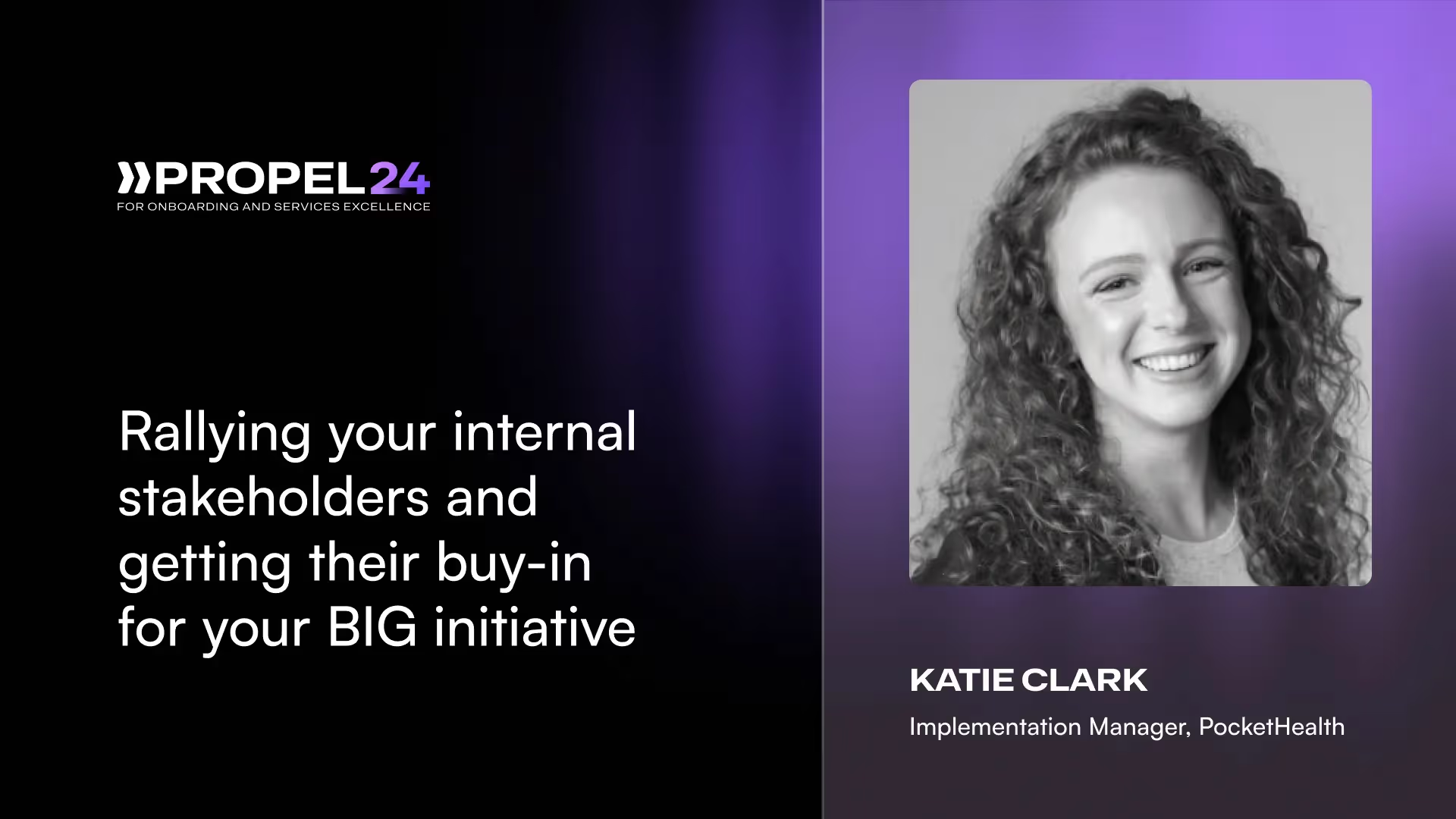The ability to effectively rally internal stakeholders and secure their buy-in is a vital skill for driving major initiatives. It not only facilitates organizational alignment and resource allocation but also equips you with the capabilities to influence and win over external stakeholders, ultimately contributing to the broader success of your organization.
But what exactly does this entail, and why is it so important?
Katie Clark, Implementation Manager at PocketHealth, broke it down for us at Propel24. She has a deep passion for scaling customer onboarding functions and developing effective team strategies. She recently become a co-owner of the CS in Focus community, based in the Greater Toronto Area (GTA), where she is dedicated to fostering growth and collaboration opportunities for customer success professionals.
In her session, she shared:
- The importance of rallying your internal stakeholders and securing their buy-in
- The need to know your audience
- How to gain momentum for your big initiative
- Strategies to overcome resistance
- Tips to celebrate success
Here’s a summary of her Propel24 talk.
Who are internal stakeholders?
Internal stakeholders can be anyone within your organization who significantly influences the decision-making process. This may include your direct supervisors, C-suite executives, or other key decision-makers who have the authority to approve or reject proposals. Essentially, anyone whose support is critical to moving your idea forward is considered an internal stakeholder.
{{demo}}
What does getting stakeholder buy-in mean?
Getting full buy-in from your stakeholders means that you have their full support and personal investment in your project’s success. It goes beyond merely obtaining a formal approval for your initiative. When stakeholders are genuinely bought in, they are committed to the project's goals and are willing to actively contribute to its successful execution, rather than just providing a passive endorsement.
Why is stakeholder buy-in important?
The significance of stakeholder buy-in cannot be overstated. In rapidly scaling organizations, where change is constant and the pace is swift, securing this buy-in is essential for several reasons. It ensures that you and your team have the necessary resources and support to align with the organization's growth trajectory. Moreover, this internal buy-in is a valuable skill that can be leveraged to build rapport and gain the trust of external stakeholders, such as users or customers. By mastering the art of rallying internal stakeholders, you enhance your ability to drive organizational success and build stronger, more persuasive relationships externally.
How to get stakeholder buy-in
Securing stakeholder buy-in is a critical component of advancing any major initiative within an organization. Here's a step-by-step guide on how to achieve this.
Step 1: Know your audience
Knowing your audience is fundamental to securing stakeholder buy-in. While internal stakeholders may vary across organizations, they can be generally categorized into three broad types based on their motivations: founders, investors, and community stakeholders.

1. Founder
Founders are typically the owners or original creators of the company. They have a deep personal and emotional investment in the organization's success and growth. For founders, the company is more than just a job; it's a passion project into which they have poured a significant part of themselves. They are usually involved in various aspects of the organization and have a broad and deep understanding of its operations. Founders are often open to taking substantial risks, as long as they feel it’s in the right direction and believe it will lead to a positive impact on the business.
2. Investor
Investors have a financial stake in the company and focus primarily on its economic success. They know where the money is coming from, they know where it's going, and they know how much can be afforded to be allocated to your new idea. They are interested in the bottom line and are driven by data and factual evidence. To win over investor stakeholders, it's crucial to present your idea with robust data and clear financial projections. While they share a common goal of the organization's success with founders, their motivation is less emotional and more analytical.
3. Community
Community stakeholders represent a broad and diverse group, often encompassing your customers, media representatives, and those managing customer relationships. These stakeholders are essential because they provide the voice of the customers and generate buzz around new initiatives. They analyze customer feedback, manage support tickets, and develop features to engage users. Community stakeholders are motivated by what is best for the customers and often juggle multiple responsibilities. They are also the ones who are likely to be adapting to the most change internally, depending on what your big idea is. So, to gain their buy-in, you must effectively communicate the 'why' and 'how' of your idea, demonstrating how it will benefit the customer base.
Each type of stakeholder has unique motivations and understanding these will help you tailor your approach to win their support effectively. By addressing the specific needs and concerns of founders, investors, and community stakeholders, you can create a compelling case for your big initiative and ensure that you have the backing needed to succeed.
Remember: Founders and investors are generally the most interested in the outcome of your big idea. Community stakeholders, on the other hand, need to fully understand the why and the how in order to commit to your big idea.
Step 2: Generating momentum
Generating momentum can significantly enhance your chances of gaining stakeholder buy-in. This process can be broken down into three key strategies: securing initial support, creating a sense of urgency, and conducting a trial run.
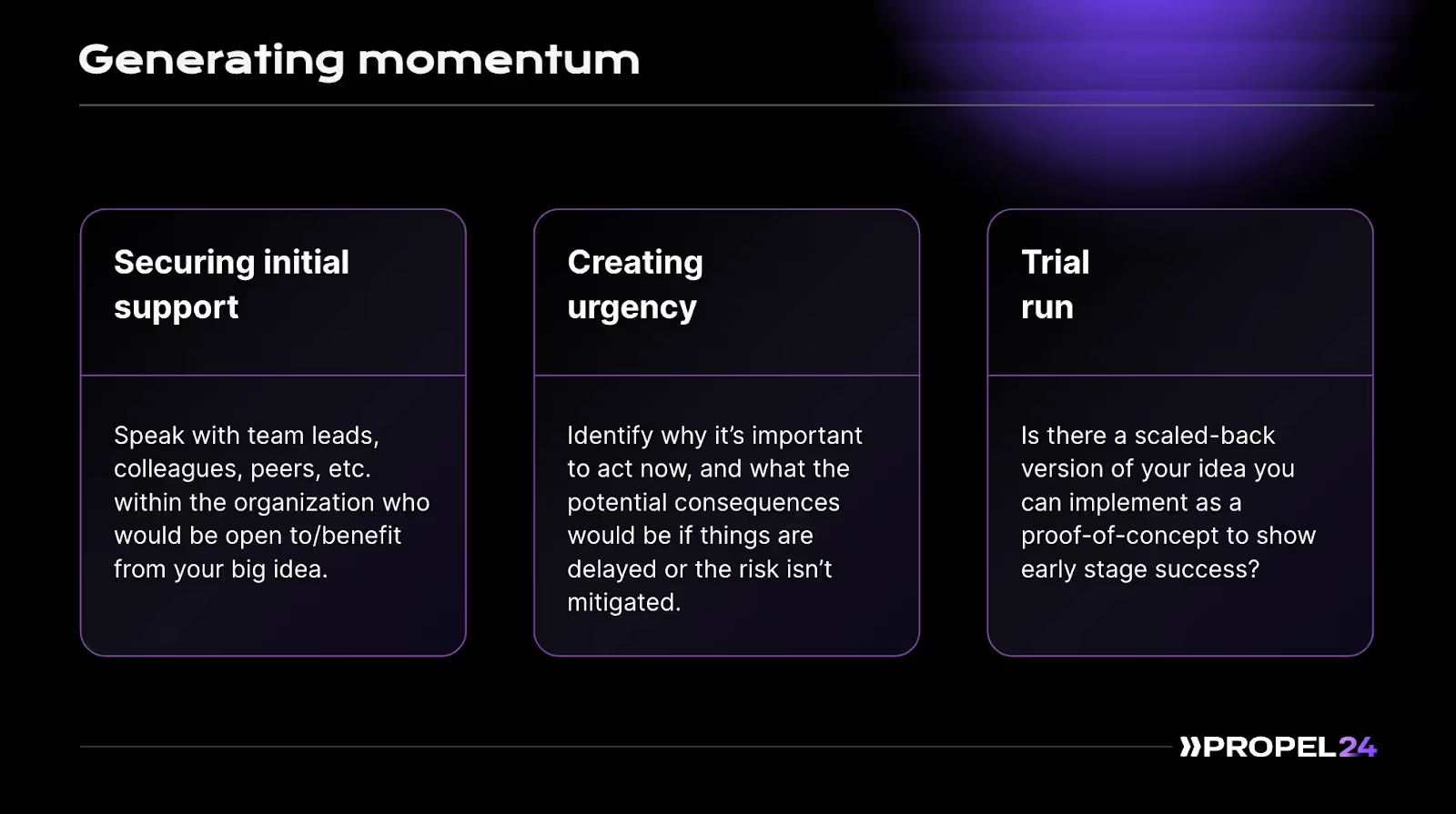
Securing initial support
The first step in generating momentum is to secure initial support from your peers, colleagues, and other leaders within your organization. When you have the backing and support, it demonstrates that your idea has potential and is worth the investment. This collective enthusiasm can create internal buzz, making it more likely that key stakeholders will take an interest in your proposal. It's much easier to get buy-in when it's not just you advocating for your idea, but when there's a visible and growing support base within the organization.
Creating urgency
Creating a sense of urgency is crucial to overcoming resistance to change. People often need a compelling reason to support a new initiative, and this means clearly communicating the potential consequences of inaction. Highlighting the pressing need for your idea can help motivate stakeholders to prioritize it. For example, if scheduling a meeting with busy executives is challenging, creating urgency can help in getting their attention and commitment. This doesn't mean starting fires or crises but rather articulating the genuine need and timely importance of your initiative to spark the necessary momentum.
Trial run
Conducting a trial run is one of the most effective ways to gain stakeholder buy-in. By implementing a scaled-down version of your idea, you can gather real-world data and demonstrate its potential impact. A trial run provides tangible evidence of your idea's benefits and allows you to refine your approach before seeking broader support and resources. For instance, you might start with a free version of a new software tool and test it with a small team, or create a focus group to gather feedback. Throughout this process, it's essential to set clear success criteria and document your processes and results meticulously. This preparation shows stakeholders that you have a well-thought-out plan and are committed to seeing it through, which can significantly enhance your credibility and the overall appeal of your pitch.
These strategies not only build a solid foundation for your initiative but also demonstrate your commitment and preparedness, making it easier to rally the support you need from stakeholders for success.
Step 3: Crafting your message
Crafting your message is arguably the most critical and time-consuming part of securing stakeholder buy-in. The key is to tell a compelling story that resonates with your audience on both an emotional and intellectual level. Our brains are naturally hardwired to respond to narratives, making stories a powerful tool for conveying complex ideas and ensuring they are remembered.
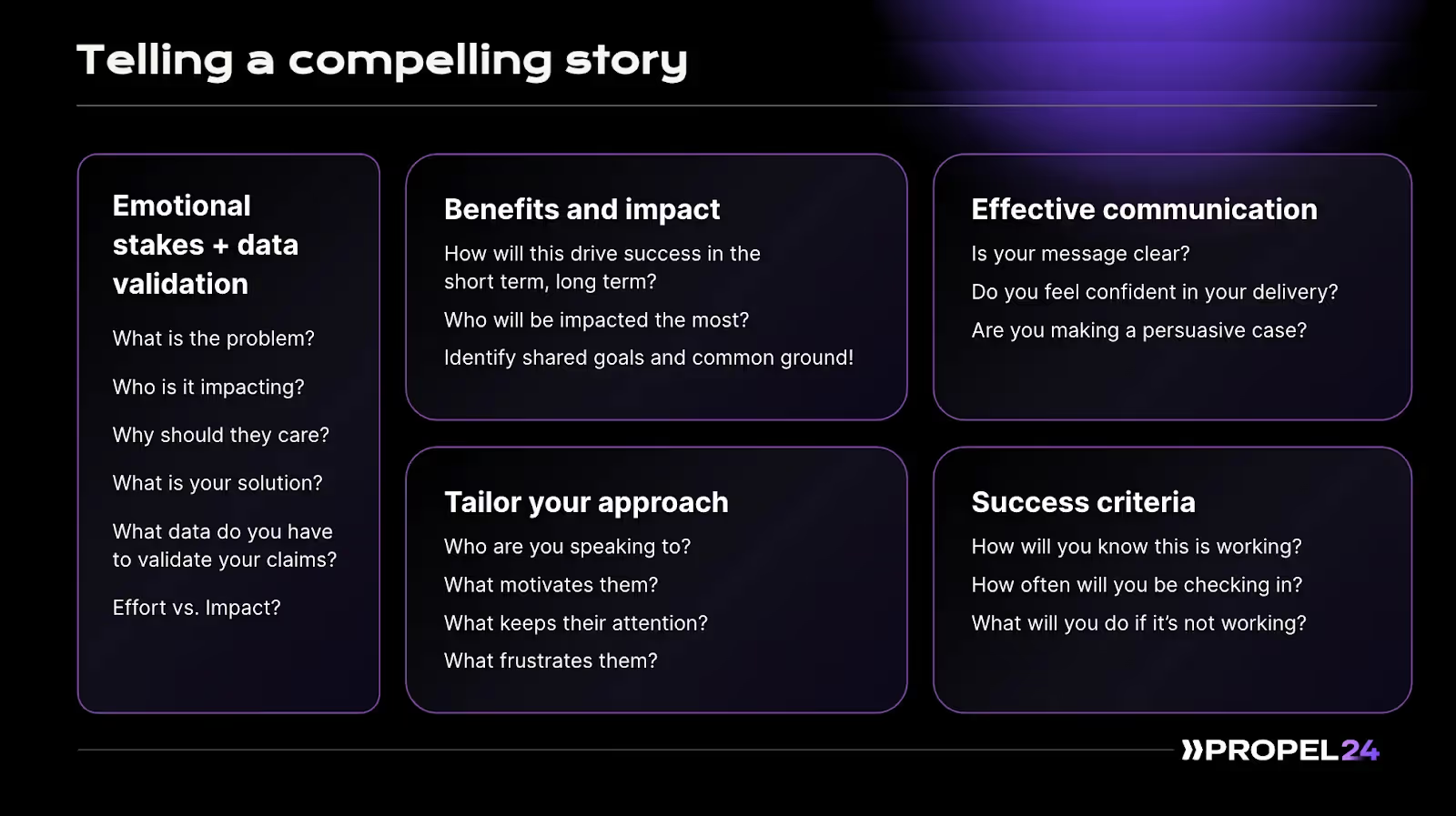
To engage your stakeholders, frame your idea within a narrative structure. Stories not only help simplify complex concepts, but also evoke emotions, and emotions are powerful motivators. When stakeholders are emotionally invested in your idea, they are more likely to support it. However, it's essential to back up the emotional appeal with solid evidence.
Here are some guiding questions to help you build a strong narrative:
- What is the problem?
- Who is it impacting?
- Why should they care about it?
- What is your solution to the problem?
- How much work will it take versus the impact of your solution?
By addressing these questions, you can create a compelling story that highlights the urgency of the problem, the feasibility of your solution, and the significant positive impact it will have.
Through all this, effective communication is all-important for crafting a compelling message. To ensure your message is well-received:
- Identify how your stakeholders best receive information: People process information in different ways. Some may prefer detailed reports and concrete data, while others might resonate more with personal anecdotes or visual presentations.
- Customize your approach accordingly: Use a mix of visual aids, emotional stories, and data-driven arguments to cover all bases. Understand the preferred communication styles of your stakeholders and tailor your message effectively.
- Do thorough research: Ensure your story and proposal are well-researched. Avoid pitching ideas that have been tried and failed without acknowledging past efforts and explaining how your approach differs.
Remember: Crafting your message involves telling a compelling story that combines emotional appeal with solid evidence. Make sure your proposal is grounded in reality, supported by data, and demonstrates a clear understanding of past initiatives and their outcomes. This diligence not only strengthens your narrative but also shows stakeholders that you have done your homework and are presenting a well-thought-out plan. And this increases your likelihood of securing their buy-in.
Step 4: Overcoming stakeholder resistance
Overcoming resistance is one of the most emotionally challenging parts of securing stakeholder buy-in. It's never easy to face rejection, especially when you've invested a lot of effort into your pitch.
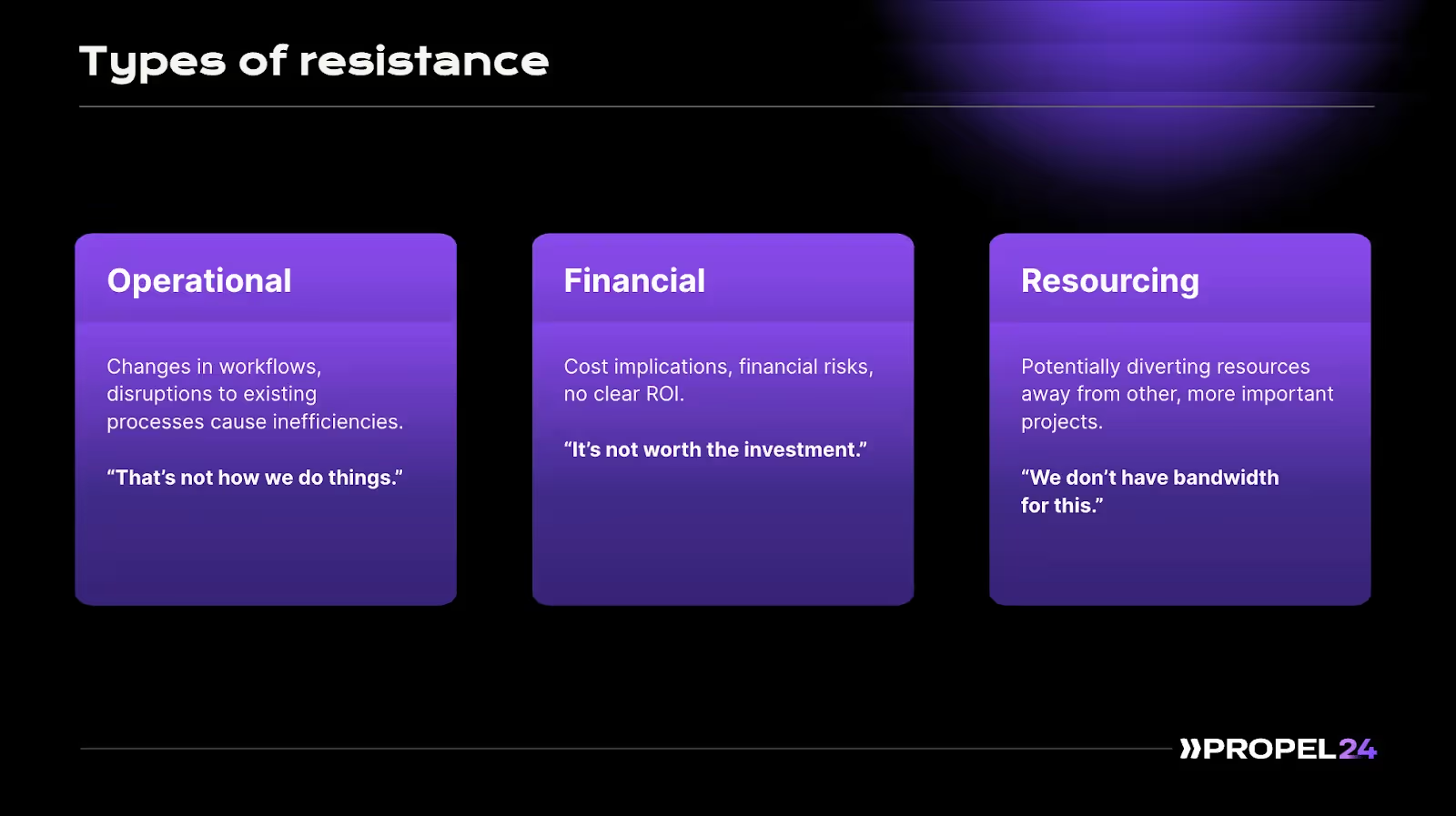
When it comes to overcoming resistance, understanding the types of resistance you may encounter can help you develop strategies to address and overcome them. The three types of resistance you may encounter from stakeholders include:
Operational resistance
Stakeholders may resist changes to workflows or processes if they believe these will cause inefficiencies or disrupt existing operations. This is often encapsulated in the phrase, "This is not how we do things". Stakeholders with a deep emotional investment in the current processes, especially those who were instrumental in creating them, are often the most resistant to these operational changes. If this stakeholder does not feel personally invested in the success of your idea, they are more likely to resist it.
Financial resistance
Cost is a significant barrier to gaining stakeholder buy-in. If stakeholders do not understand or agree with the benefits compared to the initial costs, they will likely reject the proposal, and it will be almost impossible to get the required budget for your big initiative. Financially motivated stakeholders are risk-averse and require clear evidence of potential benefits before they commit to funding.
Resourcing resistance
In a scaling environment, securing adequate resources can be a constant battle. Stakeholders may resist your idea if they believe it does not align with their goals or the organization's overall objectives. Resource allocation is often a zero-sum game, and stakeholders need to see a direct benefit to justify reallocating resources.
How do you overcome stakeholder resistance?
When it comes to overcoming these resistances, consider the following strategies:
1. To overcome operational resistances:
- Leverage initial supporters: Utilize your early supporters to advocate for your idea. Their enthusiasm can help sway more resistant stakeholders.
- Engage with stakeholders: Ask questions, be open to feedback, and show a willingness to adapt your idea based on their input. This collaborative approach can reduce resistance.
- Assign roles to stakeholders: Give stakeholders a role in the implementation process, making them feel more in control and invested in the outcome.
- Align with the core values of the organization: Tie your proposal to the company's core values to show that your initiative benefits the organization as a whole, not just your personal goals.
2. To overcome financial resistances:
- Make a cost-benefit analysis: Present a thorough cost-benefit analysis to demonstrate the long-term impact and value of your idea.
- Share success stories: Provide examples of similar initiatives that have succeeded in other organizations, including competitors or previous experiences.
- Explore alternative funding: If full funding is not feasible, identify more affordable alternatives that can still achieve your goals. This flexibility can help keep your idea alive and allow for re-pitching later.
3. To overcome resourcing resistance:
- Try and find a common ground: Identify and emphasize shared goals between your idea and the stakeholders' objectives.
- Use competitive pressure: Highlight how competitors are successfully implementing similar ideas to create a sense of urgency and the risk of falling behind.
- Set clear milestones: Outline specific deadlines and milestones to show a clear path from proposal to success, making the process more tangible and less intimidating.
- Incorporate customer feedback: Use customer testimonials to demonstrate direct demand and support for your idea, showing its relevance and potential impact.
Overcoming resistance requires a strategic approach tailored to the specific concerns of your stakeholders. By leveraging initial support, engaging in collaborative discussions, presenting robust financial justifications, and aligning your proposal with organizational goals and values, you can effectively address resistance and build a strong case for your initiative.
Step 5: Celebrating success
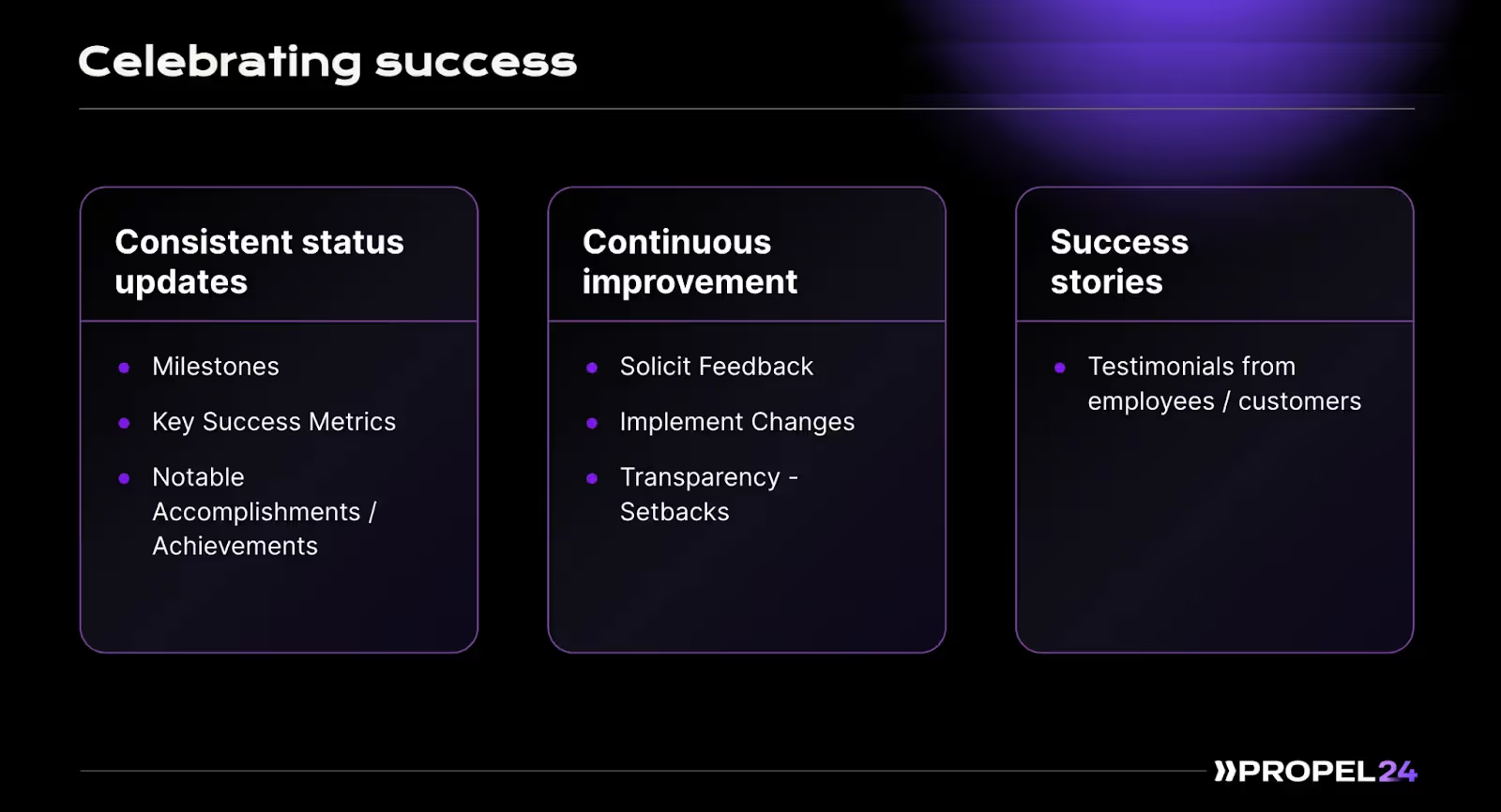
Celebrating success is an often overlooked aspect of securing and maintaining stakeholder buy-in. Once you have their support, it’s important to ensure they feel part of the journey and the achievements. This can foster continued enthusiasm and investment in your initiative. Here’s how you can effectively celebrate success and maintain momentum.
- Consistent status updates: Keep stakeholders informed with regular status updates at every milestone. This transparency not only reinforces their decision to support your initiative, but also keeps them engaged and excited about the progress. Share your key success metrics and provide detailed reports on how things are evolving. Consistent communication builds trust and shows that you value their involvement.
- Celebrate notable accomplishments publicly: Announce achievements in company-wide meetings, public Slack channels, LinkedIn, or other platforms. Recognizing successes in a public forum not only boosts team morale but also showcases the impact of your initiative to a broader audience, reinforcing its importance and value.
- Solicit and implement feedback continuously: Show stakeholders that you are committed to refining and improving your initiative based on their input. This iterative approach demonstrates responsiveness and a dedication to excellence, encouraging ongoing support and collaboration.
- Be transparent about any setbacks or challenges: Honesty fosters trust and shows that you are adaptable and capable of overcoming obstacles. Share how you’ve addressed issues and what you’ve learned from them. This openness can turn potential setbacks into opportunities for growth and further buy-in.
- Share success stories: Share success stories from individuals or teams directly impacted by your initiative. Real-world examples and testimonials provide concrete evidence of your initiative’s positive effects, reinforcing its legitimacy and value. Highlighting these stories helps stakeholders see the tangible benefits of their support.
In short, rallying your internal stakeholders and getting buy-in for your big initiative is no Herculean task. All you need to do is know your audience, craft a compelling story, and celebrate the success. By doing these three things effectively, you’ll find that most people are open to listening to you. Remember to also accept feedback and iterate on your idea to secure stakeholder buy-in and earn their continued support and enthusiasm.
Q&A with Katie Clark
Question: Can you share a personal experience where stakeholder buy-in was required for project success and what you did to achieve it?
Katie: In my previous role, before I started with PocketHealth, I was the first hire for the onboarding team at a scaling startup. One of our biggest challenges was securing the resources needed to scale effectively, including acquiring software to manage our book of business and streamline our onboarding process. This investment was significant, both financially and in terms of internal resources. To get buy-in, we highlighted how our existing processes were creating inefficiencies and bottlenecks, which delayed customer onboarding and ultimately cost us money. By framing the new tool as a solution to these issues, we showed that the initial upfront cost would be offset by the long-term benefits, including increased efficiency and reduced time-to-value for our customers. This helped us secure the necessary buy-in and resources to implement the software successfully.
Question: In today’s uncertain job market, it’s possible that a key stakeholder or financial investor supporting your big initiative might move to a different department or be let go. How do you approach this situation? Do you restart and carry out the same process again? What’s the ideal way to handle this?
Katie: In such a situation, I would first take a moment to understand the broader impact of losing that key stakeholder. This change likely affects not just my initiative but also the entire department or other organizational structures. If a replacement is brought in, it’s worth rallying the initial supporters and approaching them collectively. Instead of asserting that the new stakeholder is obligated to support the initiative because their predecessor did, I would explain why the previous stakeholder was an advocate in the first place. If the initiative has already started, I’d share the successes achieved so far. If it was just approved and not yet implemented, it’s best to revisit the reasons for the initial support and reiterate them to the new stakeholder, rather than starting from scratch. This way, you maintain continuity and reinforce the value of the initiative.
Question: Before identifying your next big initiative, how do you determine which idea will have the most significant impact on the organization when you have multiple ones?
Katie: First, I love using an effort versus impact assessment. This helps me evaluate if an initiative that requires a lot of effort will drive substantial impact compared to one that requires less effort for a smaller impact. Sometimes, starting with smaller initiatives can help build your credibility. When you demonstrate that your ideas are effective, it fosters trust and encourages investment in your proposals.
Secondly, I seek input from others in the organization. If I’m torn between a few ideas, I ask colleagues for their opinions. I might inquire if a proposed initiative could also benefit their teams or align with their goals, which helps create a united front.
Lastly, it’s useful to have a few smaller ideas ready in case a big pitch gets rejected. If your major initiative isn’t approved, you can propose a smaller, more manageable idea as a compromise. This can sometimes be more acceptable and still allows you to move forward with positive changes.
{{demo}}


